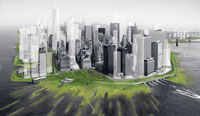 When the Water Rises
When the Water Rises
Five architects’ plans for managing a globally warmed future.Rendering courtesy of ARO and dlandstudio/MoMA
It’s easy to imagine an apocalyptically soggy future for New York—high waves soaking the hem of Lady Liberty’s robes, flash floods roaring through subway tunnels, kayakers paddling down Wall Street—and just as easy to dismiss it all as another end-of-days Hollywood fantasy. Global warming may be powerful and real, but so is denial, and the urge to postpone thinking about that particular item on the world’s to-do list is almost irresistible. Coastal cities, however, don’t have that luxury. For centuries, New York has been steadily expanding into its harbor; when the steroidal storms of the not-too-distant future start pummeling our shores, the waters will push back.
So Barry Bergdoll, the head of the Museum of Modern Art’s architecture and design department, divvied New York Harbor among five teams of designers and challenged them to figure out how a low-lying metropolis might deal with rising sea levels and violent storm surges. Their answers will appear (starting March 24) in the MoMA exhibit “Rising Currents: Projects for New York’s Waterfront,” and they vary from spongy streets to reefs made of glass or oysters to apartment buildings dangling above the brine. Despite their varied approaches, all the teams agree that the traditional solution—barricading the city behind high, hard walls—is just a start. They craft a waterfront that’s more like a beach than a bulwark: a soft urban edge that welcomes waves, drinks them up and puts them to work, and lets floodwaters ebb without drama. Bergdoll asked the architects to present paths to salvation in visual terms: “Your mission is to come up with images that are so compelling they can’t be forgotten and so realistic that they can’t be dismissed,” he told them. The result is a tour de force of visionary pragmatism.
The five teams produced innovative ways of returning New York to a time before we paved over mudflats and salt marshes, poisoned the waterways, and clogged up the coastline with landfill. In the last decade, the city has recycled swaths of waterfront wasteland into a ribbon of park and piers. The future could involve dismantling the seawall, ringing the harbor with wetlands, and embracing the city’s maritime identity. This seems at first like surrender—throw open the floodgates, let in the tides—but it’s more like jujitsu engineering. A mushy, absorbent coastline is nature’s defense against storm surges, and it doesn’t need a tryout: We know it works.
The proposals seem quixotic and expensive, but consider the reality of the Henry Hudson Parkway today, which after a moderate rainstorm often floods, narrowing to a single amphibious lane. Now imagine sitting in your car when the post-ice-melt storm surge comes muscling over the embankment, turning your Suburban into a submarine. Suddenly, you could find yourself wishing for an oyster reef.
 When the Water Rises
When the Water Rises